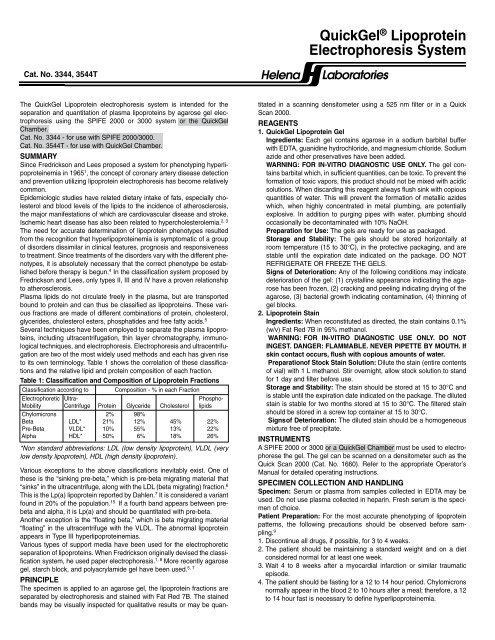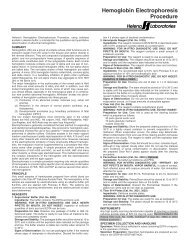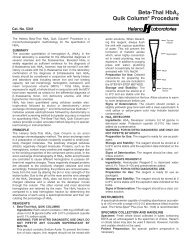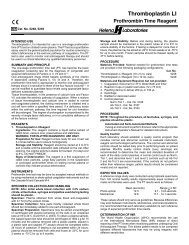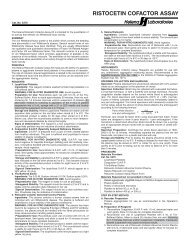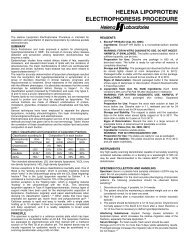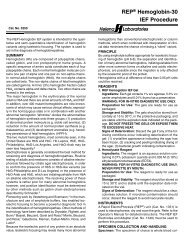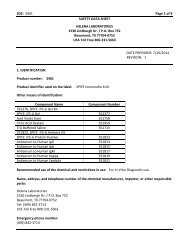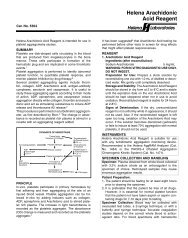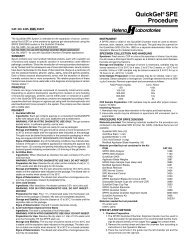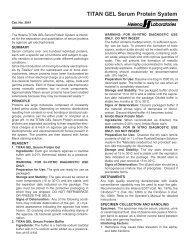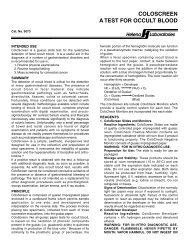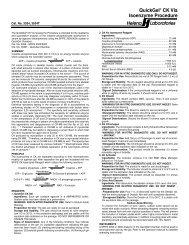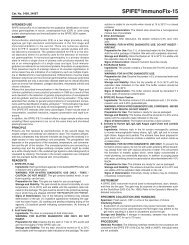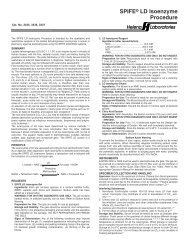QuickGel® Lipoprotein Electrophoresis System - Helena
QuickGel® Lipoprotein Electrophoresis System - Helena
QuickGel® Lipoprotein Electrophoresis System - Helena
- No tags were found...
You also want an ePaper? Increase the reach of your titles
YUMPU automatically turns print PDFs into web optimized ePapers that Google loves.
or poorly controlled insulinopenic diabetes mellitus. Primary lipidemiaarises from genetically determined factors or environmental factors ofunknown mechanism such as diet, alcohol intake, and drugs, especiallyestrogen or steroid hormones. 14 Also considered primary are those lipoproteinemiasassociated with ketosis-resistant diabetes, pancreatitis,and obesity. Diabetes mellitus and pancreatitis can be confusing, for itis often difficult to tell whether the hyperlipoproteinemia or the disease isthe causative factor.LIMITATIONSLimiting Factors: Fat Red 7B, as well as the Sudan black stains, has amuch greater affinity for triglycerides and cholesterol esters than it has forfree cholesterol and phospholipids. Bands seen after staining with thesedyes do not reflect a true quantitation of the total plasma lipids. 12 For thisreason it is not recommended that relative percentages of lipoproteinbands be used to calculate the total lipid content in each fraction from atotal plasma lipid value. Since most laboratories routinely offer total cholesteroland triglyceride levels, this information is unnecessary.Interfering Factors: Specimens collected in heparin should not be usedsince heparin alters the migration patterns of the lipoprotein fractions.Further Testing Required: Since the lipid composition of each lipoproteinfraction is variable, it is essential to determine total cholesterol and triglyceridelevels before attempting to classify a pattern. 8, 9 When it becomesnecessary to diagnose or rule out a Type III hyperlipoproteinemia, a moredefinitive quantitation of the lipoproteins such as ultracentrifugation 4 orelectrophoresis on polyacrylamide gel 13 is essential.PRIMARY LIPOPROTEINEMIASThe Fredrickson ClassificationType I: HyperchylomicronemiaCriteria: Chylomicrons present, pre-Beta normal or only slightly elevated.Alpha and Beta decreased, often markedly so. Standing plasma withmarked creamy layer.Confirmation: A measurement of post-heparin lipolytic activity (PHLA)and the demonstration of severe intolerance to exogenous fat. The conditionis rare and always familial. There has been no correlation to vasculardisease. It is thought to be due to a genetic deficiency of lipoproteinlipase. 8Type II: HyperbetalipoproteinemiaCriteria: Increased total cholesterol due to an increased Beta-lipoproteincholesterol. Alpha cholesterol usually normal or low.Type IIa: normal pre-Beta, normal triglycerides, plasma clear.Type IIb: increased pre-Beta and triglycerides, plasma clear to slightlyturbid with no creamy layer.This is one of the most common familial forms of hyperproteinemias.Secondary causes: Myxedema, myelomas, macroglobulinemias, nephrosis,liver disease, excesses in dietary cholesterol and saturated fats.Type III: “Broad Beta” - Abnormal <strong>Lipoprotein</strong>Criteria: Presence of triglyceride burdened lipoprotein of abnormal compositionand density. Cholesterol and triglyceride elevated. The abnormalmaterial has broad beta electrophoretic mobility but separates with VLDLin the ultracentrifuge. Plasma turbid to cloudy. The abnormal lipoproteinis also known as “floating Beta”. The condition is rare.Confirmation: Polyacrylamide gel electrophoresis 13 or ultracentrifugestudies to demonstrate the abnormal lipoprotein.Type IV: Carbohydrate Induced Endogenous HypertriglyceridemiaCriteria: Increased pre-Beta, increased triglycerides, normal or slightlyincreased total cholesterol. Alpha and Beta lipoprotein usually normal.(An increased pre-Beta with normal triglyceride level is seen with the normalvariant “sinking pre-Beta.” Such samples do not belong to Type IV.)Secondary causes: Nephrotic syndrome, diabetes mellitus, pancreatitis,glycogen storage disease, and other acute metabolism changes wheremobilization of free fatty acids is increased. Endogenous triglyceridesare very sensitive to alcohol intake, emotional stress, diet and changesin weight. Little effect is seen with exogenous triglyceride intake. Ninetypercent of people with familial Type IV have an abnormal glucose tolerance.Probably the most common type of hyperlipoproteinemia reflectingan imbalance in synthesis and clearance of endogenous triglycerides.Type V: Mixed Triglyceridemia (carbohydrate and fat included)Criteria: Increased exogenous and endogenous triglycerides, cholesterolincreased, chylomicrons present, pre-Beta increased, Beta normalto slightly increased.Secondary causes: Nephrosis, myxedema, diabetic acidosis, alcoholism,pancreatitis, glycogen storage disease and other acute metabolicprocesses. 4Note: Only Types II, III, and IV have been correlated to vascular disease.THE ALPHA LIPOPROTEINS IN DISEASEMarked increases in the Alpha lipoproteins are seen in obstructive liverdisease and cirrhosis. Marked decreases are seen in parenchymal liverdisease. Tangier’s disease is a rare genetic disorder characterized bythe total absence of normal Alpha lipoproteins. Heterozygotes exhibitdecreased levels of Alpha lipoproteins. 8 It should be noted that hyperestrogenemia(pregnancy or oral contraceptive use) may cause moderateelevations in the Alpha lipoproteins. 12DECREASES IN THE BETA LIPOPROTEINSAbetalipoproteinemia is a primary inherited defect characterized bysevere deficiency of all lipoproteins of density less than 1.063 (all but theAlpha lipoproteins). It is accompanied by numerous clinical symptomsand life expectancy is limited. A few cases of familial hypobetalipoproteinemiahave been reported. There is some evidence that the mutationis different from that producing abetalipoproteinemia.LIPOPROTEIN-X<strong>Lipoprotein</strong>-X is an abnormal lipoprotein often seen in patients with liverdisease. It consists of unesterified (free) cholesterol, phospholipids andprotein. It migrates slower than LDL. Because of its particular lipid contents,it stains poorly or not at all with the usual lipid stains and so is notusually detected by standard lipoprotein electrophoretic methods.PERFORMANCE CHARACTERISTICSSPIFE 2000/3000PRECISIONWithin Run precision was evaluated by analyzing one sample 10 timeson one gel. N = 10<strong>Lipoprotein</strong> Fraction Mean % SD CVAlpha 39.2 0.9 2.2%Pre-Beta 20.6 1.1 5.2%Beta 40.2 1.7 4.2%Between Run: Normal samples were run 10 times each on 12 gels withthe following results. N = 120<strong>Lipoprotein</strong> Fraction Mean % SD CVAlpha 39.7 1.9 4.8%Pre-Beta 19.2 2.6 13.7%Beta 41.1 2.9 7.1%CORRELATIONCorrelation studies were performed on 50 normal and abnormal specimens.The QuickGel <strong>Lipoprotein</strong> method on the SPIFE was comparedto the SPIFE <strong>Lipoprotein</strong> method resulting in the following linear regression:N = 100X = SPIFE <strong>Lipoprotein</strong>Y = 0.929X + 2.372 Y = QuickGel <strong>Lipoprotein</strong>r = 0.957QuickGel ChamberPRECISIONWithin Run: A patient sample was run 10 times on one gel. N = 10<strong>Lipoprotein</strong> Fraction Mean % SD CVAlpha 39.2 1.1 2.8%Pre-Beta 17.6 0.8 4.3%Beta 43.2 1.5 3.4%Between Run: A control and a patient sample were run alternately oneight gels. N = 40Control<strong>Lipoprotein</strong> Fraction Mean % SD CVAlpha 39.3 2.7 6.8%Pre-Beta 20.5 1.1 5.4%Beta 40.2 2.6 6.6%5
Patient<strong>Lipoprotein</strong> Fraction Mean % SD CVAlpha 39.7 2.4 6.0%Pre-Beta 17.5 0.7 4.0%Beta 42.8 2.3 5.3%CORRELATIONCorrelation studies were performed on 27 normal and abnormal specimens.The QuickGel <strong>Lipoprotein</strong> method on QuickGel chamber wascompared to QuickGel <strong>Lipoprotein</strong> run on SPIFE resulting in the followinglinear regression:N = 27Y = 0.992X + 0.258r = 0.974X = QuickGel <strong>Lipoprotein</strong> on SPIFEY = QuickGel <strong>Lipoprotein</strong> on QuickGel chamberBIBLIOGRAPHY1. Fredrickson, D.S., and Lees, R.S., A <strong>System</strong> for PhenotypingHyperlipoproteinemias, Circulation, 31(3):321-327, 1965.2. Henry, R.J. Ed., Clinical Diagnosis and Management of LaboratoryMethods, 20th Ed. W.B. Saunders Co., New York, 240-245, 2001.3. Lewis, L.A. and Opplt, J.J. Ed., CRC Handbook of <strong>Electrophoresis</strong>Vol II <strong>Lipoprotein</strong>s in Disease, CRC Press, Inc., Florida, 63-239,1980.4. Levy, R.I. and Fredrickson, D.S., Diagnosis and Management ofHyperlipoproteinemia, Am. J. Card. 22(4):576-583, 1968.5. Houstmuller, A.J., Agarose-gel <strong>Electrophoresis</strong> of <strong>Lipoprotein</strong>s: AClinical Screening Text, Koninklijke Van Gorcum and Comp. TheNederlands, p. 5, 1969.6. Stonde, N.J. and Levy, R.I., The Hyperlipidemias and Coronary ArteryDisease, Disease-a-Month, 1972.7. Dahlen, Gosta, The Pre-Beta <strong>Lipoprotein</strong> Phenomenon in Relationto Serum Cholesterol and Triglyceride Levels: The Lp(a) <strong>Lipoprotein</strong>and Coronary Heart Disease, Umea University Medical Dissertations,Sweden, No. 20, 1974.8. Fredrickson, D.S., Levy, R.I., Lees, R.S., Fat Transport in <strong>Lipoprotein</strong>s- An Intergrated Approach to Mechanisms and Disorders, N. Eng.Jour. Med., 276:34-42, 94-103, 148-156, 215-226, 273-281, 1967.9. Fredrickson, D.S., When to Worry about Hyperlipidemia, Consultant,Dec., 1974.10. Houstmuller, A.J., Heparin Induced Post Beta <strong>Lipoprotein</strong>, Lancet7470(II), 976, 1966.11. Hatch, F.T. and Lees, R.S., Practical Methods for Plasma <strong>Lipoprotein</strong>Analysis, Advan. Lipid Res. 6:1, 1968.12. Davidsohn, I. and Henry, J.B., Todd-Sanford: Clinical Diagnosis byLaboratory Methods, 15th ed., p. 638-639, 1974.13. Masket, B.H., Levy, R.I., and Fredrickson, D.S., The Use of PolyacrylamideGel <strong>Electrophoresis</strong> in Differentiating Type III Hyperlipoproteinemia,J. Lab & Clin. Med., 81(5):794-802, 1973.14. World Health Organization Memorandum: Classification of Hyperlipidemiasand Hyperlipoproteinemias, Circulation, 45:501-508,1972.15. Lynch, G.J., et al, Routine Lipid Screening by Cholesterol Staining<strong>Electrophoresis</strong> - Including <strong>Lipoprotein</strong>(a) Cholesterol (Lp(a)-c), Aust.Jour of Med Sci, 19:123-126, Nov. 1998.QuickGel <strong>Lipoprotein</strong> <strong>System</strong>Cat. No. 3344QuickGel <strong>Lipoprotein</strong> Gels (10)<strong>Lipoprotein</strong> Stain (1 vial)QuickGel Blotter X (20)SPIFE Blotter C (10)Applicator Blade Assembly-20 Sample (10)Other Supplies and EquipmentThe following items, needed for performance of the QuickGel<strong>Lipoprotein</strong> Procedure, must be ordered individually.Cat. No.SPIFE 2000 Analyzer 1130SPIFE 3000 Analyzer 1088Quick Scan 2000 1660Lipotrol (5 x 1.0 mL) 5069REP Prep 3100REP Gel Staining Dish (10) 1362Gel Block Remover 1115SPIFE Disposable Sample Cups (Deep Well) 3360SPIFE/QuickGel Electrodes 1111SPIFE/QuickGel Holder 3358QuickGel Chamber Alignment Guide 86541003QuickGel Dispo Cup Tray 3353SPIFE/QuickGel Disposable Stainless Steel Electrodes 3357Cat. No. 3544TQuickGel <strong>Lipoprotein</strong> Gels (10)<strong>Lipoprotein</strong> Stain (1 vial)QuickGel Blotter C (10)QuickGel Blotter X (20)QuickGel Blotter A (10)QuickGel Templates (10)Other Supplies and EquipmentThe following items, needed for performance of the QuickGel<strong>Lipoprotein</strong> Kit, must be ordered individually.Cat. No.QuickGel Chamber 1284QuickScan 2000 1660Lipotrol (5 x 1.0 mL) 5069REP Gel Staining Dish (10) 1362REP Prep 3100QuickGel Gel Block Remover 1262For Sales, Technical and Order Information and Service Assistance, call800-231-5663 toll free.<strong>Helena</strong> Laboratories warrants its products to meet our published specifications and to be free fromdefects in materials and workmanship. <strong>Helena</strong>’s liability under this contract or otherwise shall be limitedto replacement or refund of any amount not to exceed the purchase price attributable to the goods asto which such claim is made. These alternatives shall be buyer’s exclusive remedies.In no case will <strong>Helena</strong> Laboratories be liable for consequential damages even if <strong>Helena</strong> has beenadvised as to the possibility of such damages.The foregoing warranties are in lieu of all warranties expressed or implied including, but not limited to,the implied warranties of merchantability and fitness for a particular purpose.Shading indicates that the text has been modified, added or deleted.6Beaumont, TX Pro. 1794/09(3)


